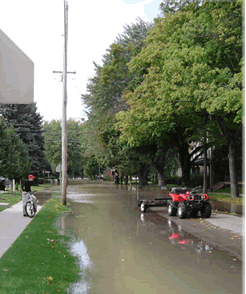
| Home > The Scientists > Phoebe Swift | |||||||||||||||
Phoebe was awarded the Hobart Water Steve Balcombe Scholarship to study engineering at the University of Tasmania in 2002, and when she began her degree she wasn’t sure which engineering discipline she would specialise in. To help make a decision, Phoebe found it beneficial to meet with practising engineers and discuss their work focus. “There are so many different facets to engineering,” says Phoebe, “but what I love most is how engineering combines research and understanding with practical application of the fundamentals, whether it be in the design of a bridge, or increasing the efficiency of hydro-electricity, or improving the supply and distribution of quality drinking water” says Phoebe.
Phoebe is now in the fourth year of a Bachelor of Civil Engineering, in the Honours stream. Her Honours project is Pipe Break Inundation and Consequence Assessment, which she is examining with the assistance of Hobart Water and Hydro Tasmania. “The aim of my project is to develop a consequence assessment model through the preparation of a theoretical pipe burst inundation map. The consequences of the failure are a potential factor in the scheduling of pipe replacement, repair and rehabilitation,“ says Phoebe. Her project also aims to investigate several engineering software programs designed for modelling open channel flow, which have the potential to improve the assessment process. “For me, the highlight of my degree has been my work experience with Hobart Water (also a requirement of the Bachelor of Engineering degree). During my time at Hobart Water I have also seen my first design project through to construction – an off-take to supply the new Kingston Heights Reservoir. As part of the course work I have also designed a theoretical multi-storey carpark for UTAS and a grandstand for the Sandy Bay footy club. “ When she finishes her degree at the end of this year, Phoebe’s not certain which career path she will follow, but she does have a number of goals she would like to achieve. “I’m looking forward to exploring many of the facets of Civil Engineering – Hydraulic, Geotechnical and Structural – and I have always had an interest in returning to University at some stage – perhaps to do a PhD or to work as a lecturer. In the first few years as a Graduate Engineer I will work towards obtaining Chartered Status (professional recognition by Engineers Australia).” Phoebe plans to stay in Tasmania for several years and then take the opportunity to travel and work overseas as an engineer. “I will however always come back to Tasmania, I love this place!” said Phoebe. Along with her studies, Phoebe is involved with Young Engineers Australia (YEA). “YEA represents approximately 20,000 Engineers Australia members across all disciplines of engineering and is the largest single group of young engineers in the country. “For the past year I have been Campus Coordinator for the Tasmanian division of YEA, and have recently been appointed as Vice Chair of the committee,” says Phoebe. “As CC, I have promoted Engineers Australia on campus and organised events to benefit young student engineers, including a Presentation Skills Workshop and a Workplace Level II First Aid Course (which was once a requirement of the Engineering Degree).” Find out more about Phoebe's work Key words: Engineering, Hydrology What
is Inundation Mapping?
Useful
Websites:
|
|||||||||||||||


